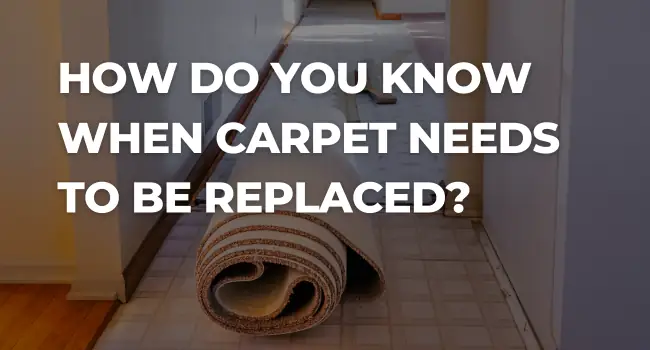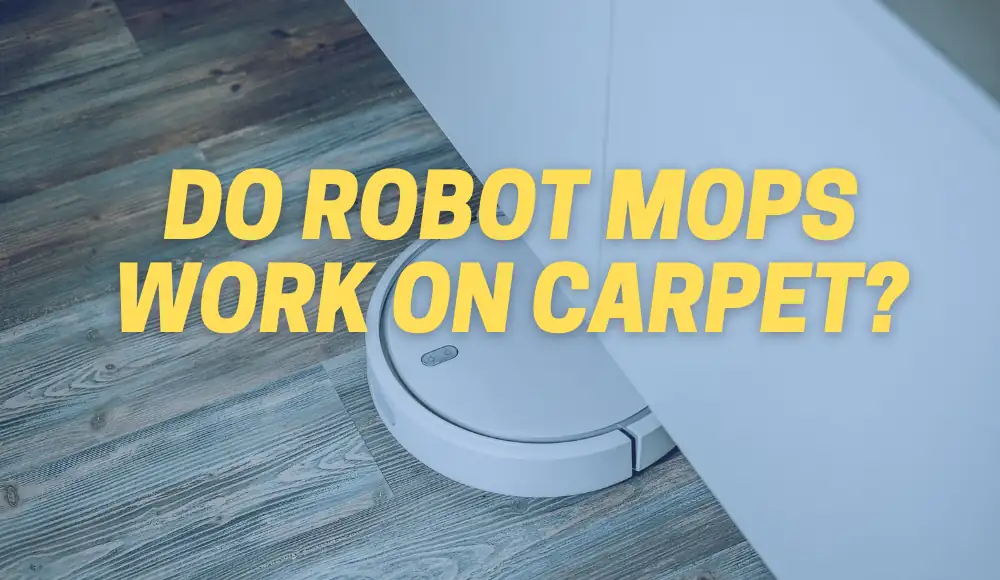Last updated on October 29th, 2023 at 03:16 am
If you’ve been walking on the same carpet for years, you might be wondering when it’s time to bid farewell to your old floor companion and welcome a fresh, cozy replacement.
Replace carpet is a phrase that often crosses the minds of homeowners who want to maintain a clean and comfortable living space. In this guide, we’ll delve into the world of carpets, exploring their lifespan, signs of wear, and when it’s a good idea to consider a change.
What Does Old Carpet Feel Like?
Imagine stepping into your home after a long day, ready to unwind. As you walk across the living room, you notice an unevenness beneath your feet, almost like walking on a lumpy path. Your carpet’s once-plush texture has transformed into a rough and worn surface that no longer offers the comfort it once did.
Old carpet tends to lose its resilience over time. It may feel flat, matted, and uneven due to constant foot traffic, furniture weight, and exposure to sunlight.
Additionally, signs of wear, like fraying edges or loose fibers, might start to become more noticeable. This is your carpet’s way of letting you know it’s seen better days.
What is the Life Expectancy of New Carpet?
When you first install a carpet, it’s like rolling out a welcome mat for your home. New carpets are vibrant, soft, and full of life. But how long can you expect this freshness to last?
The life expectancy of a new carpet can vary depending on factors like the carpet type, quality, foot traffic, and maintenance. On average, well-maintained carpets can last anywhere from 5 to 15 years.
However, it’s important to note that different areas of your home may experience varying levels of wear. For instance, a carpet in a high-traffic hallway might show signs of aging sooner than one in a guest bedroom.
Should I Replace 15-Year-Old Carpet?
So, you’ve been living with the same carpet for around 15 years, and you’re wondering if it’s time to make a change. While there’s no definitive answer, there are a few indicators that might sway your decision.
- Inspect the carpet for visible signs of wear, like significant fading, matting, or stubborn stains that refuse to budge.
- Take a moment to consider your lifestyle too.
- Have there been changes in your household, such as new pets or increased foot traffic?
- If you’re starting to notice a decline in both appearance and comfort, it might be a good idea to explore replacement options.
How Can You Tell If Carpet Needs To Be Replaced?
Your carpet has been a steadfast companion, providing comfort and style to your home for years.
But like all good things, its time might eventually come to an end. So, how can you tell if your loyal floor covering is ready to pass the torch to a new one?
Let’s embark on a carpet detective journey and decode the signs that indicate it’s time to replace carpet.
1. Worn-Out Wonders: Faded and Flattened Fibers
Take a closer look at your carpet. Are the once-vibrant colors now a muted memory of their former selves? Do you notice patches where the fibers have lost their luster? Fading and flattening are telltale signs of a carpet that has weathered its fair share of foot traffic and spills. If your carpet has lost its visual appeal and no amount of cleaning seems to revive it, it might be signaling that it’s ready to retire.
2. Stubborn Stains: The Battle That Won’t End
We’ve all been there – that accidental spill that leaves an indelible mark on your carpet’s soul. While some stains can be banished with a bit of elbow grease and stain remover, others prove to be more tenacious. If your carpet is sporting a collection of battle scars in the form of stubborn stains that just won’t budge, it’s a sign that replacement might be your best course of action.
3. Crunchy Texture: Matting and Matted Mess
The lush texture that once greeted your feet with a plush embrace might now feel more like a tangled mess. Matting occurs when carpet fibers become flattened and entangled, resulting in a less-than-inviting texture. If your carpet has transformed from a soft cloud into a crunchy conundrum, it’s time to consider a fresher foundation.
4. Odorous Odyssey: Lingering Unpleasant Smells
A carpet that has seen its fair share of spills, accidents, and everyday life might start to emit odors that refuse to leave. Despite your best cleaning efforts, if your carpet harbors unpleasant smells that persist, it could be an indication that deep-seated grime has taken residence. A replacement can usher in a breath of fresh air and bid adieu to lingering odorous odysseys.
5. Allergy Ailments: A Haven for Allergens
Carpets can inadvertently turn into cozy homes for allergens like dust mites, pet dander, and pollen. If you or your family members are experiencing heightened allergy symptoms that seem to worsen indoors, your carpet might be the hidden culprit. Regular cleaning can alleviate the issue to an extent, but if allergy ailments persist, it might be time to consider a carpet replacement to create a healthier indoor environment.
6. Unwanted Wrinkles: Ripples in the Story
If your carpet has developed wrinkles, ripples, or bulges, it’s not just an aesthetic concern – it’s also a potential safety hazard. Loose carpeting can pose a tripping risk, especially in high-traffic areas or on stairs. If you notice your carpet resembling a topographic map rather than a smooth surface, it’s a clear indicator that a replacement is in order.
7. Life’s Footprints: Irreversible Wear and Tear
Carpets have an uncanny ability to bear witness to life’s moments – from children’s first steps to exuberant family gatherings. However, as time marches on, these footprints can manifest as irreversible wear and tear. Frayed edges, unraveling seams, and exposed backing are signs that your carpet has bravely fulfilled its duty and might be ready to retire gracefully.
8. Age and Adventure: The 10 to 15-Year Milestone
A general rule of thumb is that well-maintained carpets tend to have a lifespan of around 10 to 15 years. As your carpet approaches this milestone, it’s wise to pay closer attention to its condition. If it’s showing multiple signs of wear and tear, it might be an opportune time to bid farewell and welcome a new carpet that’s ready for the adventures that lie ahead.
What is the Life Expectancy of Wall-to-Wall Carpet?
Wall-to-wall carpeting is a luxurious addition to any home, providing a seamless and cozy flooring solution. But how long can you expect this continuous expanse of comfort to endure?
Similar to other types of carpet, the life expectancy of wall-to-wall carpet depends on various factors. Higher-quality carpets, along with proper care and maintenance, can last anywhere from 10 to 20 years.
Regular vacuuming, prompt stain removal, and occasional professional cleaning can contribute to extending the lifespan of your wall-to-wall carpet.
How Long Does Cheap Carpet Last?
Not all carpets are created equal, and this holds true for their lifespan as well. If you’ve opted for a budget-friendly carpet, you might be wondering how long it’s likely to hold up under daily use.
Cheap carpets typically have a shorter life expectancy compared to their higher-end counterparts.
On average, you can expect a budget carpet to last around 3 to 5 years with proper care. While they might be an economical choice upfront, keep in mind that you may need to replace them more frequently, which could end up costing you more in the long run.
How Long Does Carpet Last on Stairs?
Staircases are high-traffic areas that experience concentrated wear due to repeated up-and-down movement. Carpeting stairs can add both safety and comfort, but it’s essential to choose a durable option.
Carpets on stairs generally have a shorter lifespan than those in other areas of your home. Depending on the quality and type of carpet, you can expect stair carpeting to last around 5 to 15 years. Factors such as the number of residents in your home, the frequency of stair usage, and the type of footwear worn can impact the carpet’s longevity.
How Often Should Residential Carpet Be Replaced?
The frequency of replacing residential carpet varies based on several factors, including carpet quality, maintenance routines, and household dynamics.
As a general guideline, consider the following:
- High-Traffic Areas: Carpets in high-traffic zones like hallways, entryways, and living rooms tend to wear out more quickly. These might need replacement every 5 to 10 years.
- Moderate-Traffic Areas: Bedrooms and guest rooms typically experience less wear and tear. Carpets in these areas can last 10 to 15 years or longer.
- Low-Traffic Areas: Areas that see minimal use, such as formal dining rooms, may have carpets that last 15 years or more.
Remember that regular maintenance, such as vacuuming, spot cleaning, and professional deep cleaning, can extend the life of your residential carpet.
What to Know About Replacing Carpet
When the time comes to replace your carpet, there are a few key considerations to keep in mind:
- Carpet Type: Choose a carpet type that suits your lifestyle. For instance, if you have pets or children, opt for a carpet that’s stain-resistant and easy to clean.
- Professional Installation: Proper installation is crucial for maximizing the lifespan of your new carpet. Hiring a professional ensures that it’s fitted correctly and securely.
- Maintenance: Establish a regular cleaning and maintenance routine to keep your new carpet looking fresh and extend its life.
- Environmental Impact: Consider eco-friendly carpet options made from sustainable materials if you’re conscious of your environmental footprint.
Carpet Replacement: A Fresh Start
In conclusion, the decision to replace carpet involves a blend of practicality and aesthetics. Old carpets show their age through diminished comfort, fraying edges, and faded colors.
New carpets bring life and warmth to your living spaces, but their longevity depends on factors like quality, maintenance, and usage patterns.
Whether you’re pondering the lifespan of wall-to-wall carpet or wondering if it’s time to part ways with a 15-year-old floor covering, it’s essential to assess your carpet’s condition and your household’s needs.
With proper care and timely replacement, you can ensure that your floors remain a source of comfort and style for years to come.



